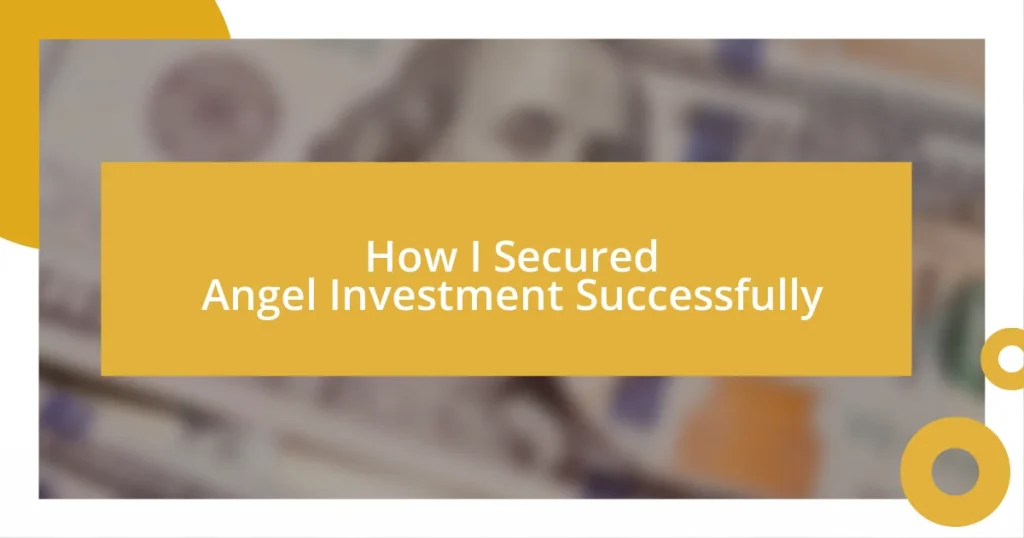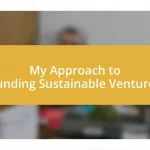Key takeaways:
- Angel investment provides funding and mentorship opportunities, which can validate and support early-stage businesses.
- Preparing with a strong business plan, organized financials, and an engaging pitch is crucial to attracting investors.
- Building and maintaining genuine relationships with investors through follow-ups and shared successes fosters long-term partnerships.

Understanding angel investment basics
Angel investment is essentially funding provided by affluent individuals to early-stage businesses, often in exchange for equity. I remember the excitement and nervousness I felt when I first approached potential angel investors; navigating this new world felt daunting. But then, it occurred to me—these investors aren’t just looking to place their money somewhere; they’re searching for opportunities to mentor and grow alongside passionate entrepreneurs.
What truly sets angel investors apart is their willingness to take risks on startups that traditional banks often shy away from. I once had a conversation with an angel investor who described his decision-making process as equal parts gut feeling and analytical evaluation. It’s not just about the numbers; it’s about the story behind the business and the passion of the entrepreneur. Have you ever considered what your own story would sound like to someone else?
Moreover, angel funding often serves as a critical lifeline for startups, providing the capital needed to turn ideas into tangible products. When I received my first angel investment, it felt like a validation of my hard work and dreams. It wasn’t just funding; it boosted my confidence and opened doors to invaluable networks of support. The emotional journey of securing angel investment can be as rewarding as the monetary gain itself, creating partnerships that often last well beyond the initial funding round.

Preparing your business for investment
Before approaching potential investors, it’s crucial to have your business well-prepared. I learned this firsthand when I meticulously organized my financial documents and crafted a convincing business plan. When investors see that you’ve done your homework, it not only builds their confidence in your venture but also demonstrates your commitment and professionalism.
Here are some essential steps to prepare your business for investment:
- Develop a strong business plan: Clearly outline your vision, mission, target market, and financial projections.
- Get your financials in order: Have accurate reports available, including income statements and cash flow projections; this shows you understand your business’s health.
- Build a compelling pitch: Craft a narrative that highlights your story and the problem your business solves.
- Know your market and competition: Be ready to discuss how you stand out and your strategies for differentiation.
- Show traction: Whether through sales, partnerships, or user engagement, demonstrating progress can entice investors.
- Foster relationships: Networking with potential investors far in advance can create familiarity and trust.
Every little detail matters. When I prepared for my pitch, I even practiced in front of a mirror, hoping to channel my nerves into something authentic yet confident. That effort to refine my delivery paid off immensely during my meeting with investors.

Crafting an effective pitch
Crafting an effective pitch is often the make-or-break moment for securing angel investment. I recall my first pitch, where I was so nervous that my hands were shaking. It taught me the importance of clarity and conciseness. Investors appreciate a pitch that gets straight to the point while still conveying the essence of your business. When I trimmed the fluff and focused on my unique selling proposition, I could feel the room’s energy shift in my favor.
The art of storytelling can greatly enhance your pitch. Sharing personal anecdotes about your entrepreneurial journey—like overcoming a significant challenge or a breakthrough moment—can resonate deeply with investors. I remember vividly describing my persistent late nights and the sacrifices I made to bring my vision to life. That genuine passion not only engaged my audience but also established an emotional connection that made my pitch memorable.
Use visuals effectively to highlight key data points without overwhelming your audience. Visuals can create a compelling narrative that supplements your spoken words. During my pitch, I included a simple infographic that illustrated market growth potential, making it easier for investors to grasp critical information quickly. Ultimately, crafting an effective pitch is about striking the right balance between engaging storytelling and actionable insights that empower investors to believe in you and your mission.
| Key Elements | Tips for a Compelling Pitch |
|---|---|
| Clarity | Be direct; avoid jargon and focus on your unique value. |
| Storytelling | Share authentic experiences to connect emotionally with investors. |
| Visual Aids | Use simple visuals to support data without cluttering your pitch. |

Building relationships with investors
Building relationships with potential investors is an essential part of the fundraising process. I remember attending a networking event where I initiated conversations with several investors, not with a pitch in mind, but to learn about their interests and experiences. This approach made me genuinely curious, and it created a relaxed atmosphere that allowed for more authentic interactions.
One thing that truly surprised me is the value of follow-ups. After my initial meetings, I sent personalized thank-you notes highlighting something specific we discussed. It’s amazing how this small gesture helped keep my name fresh in their minds and demonstrated my appreciation. Have you ever thought about how a simple thank-you can turn a casual conversation into a lasting connection?
Over time, I found that sharing personal insights about my journey, including my entrepreneurial struggles and victories, made me more relatable to investors. I wasn’t just a startup founder; I was someone willing to be vulnerable. This transparency fostered trust, and I felt that the more I opened up, the more the investors were inclined to invest not just in my business but in me as a person.

Demonstrating market potential
Demonstrating market potential is crucial in attracting angel investors. I remember during one pitch where I showcased a detailed market analysis; it wasn’t just numbers on a slide, but a reflection of years spent understanding my industry. I highlighted the growing demand for my product, explaining how changing consumer behaviors were driving that surge. Investors want to see not just where you are, but where the opportunity lies ahead—it’s the lighthouse guiding them toward investment decisions.
In my experience, backing claims with real data makes everything more credible. I shared insights from recent industry reports and customer surveys I conducted, which sparked genuine interest from investors. The moment I mentioned that my potential market was set to double in the next five years, I could see their interest piquing. How often do we overlook the power of data? When I paired statistics with a compelling narrative, it not only reinforced my points but also painted a vivid picture of what was possible.
I also learned the importance of direct engagement when discussing market potential. Picture this: I asked my audience what trends they saw influencing our industry. When investors began sharing their insights, I found it opened a door for deeper discussions about my business model in the context of those trends. This collaborative approach not only demonstrated market potential but also positioned me as someone who values input and insight, further strengthening the bond with potential backers.

Negotiating the investment terms
Negotiating the investment terms can feel a bit like a tricky dance. I remember when I first faced this stage, sitting across the table from seasoned investors who had numerous deals under their belts. It struck me that clarity was key; I made sure to articulate what I wanted while also remaining open to their input. Have you ever tried to navigate a conversation where both parties had different goals? It requires building a mutual understanding to reach a satisfactory agreement.
One tactic I employed was to prioritize my needs without losing sight of theirs. For example, I expressed my preference for a reasonable valuation but with a willingness to be flexible on payment terms. That willingness created a collaborative atmosphere, where I sensed the investors were more inclined to find a middle ground. I found that establishing common interests was invaluable; it’s remarkable how a simple alignment in goals can ease the tension in negotiations.
Reflecting on those negotiations, I realized that the emotional aspect is just as important as the numbers. During a particularly tense moment, I shared why my business mattered to me, bringing a personal story into the mix. The investors appreciated my passion, and that connection shifted the conversation from cold transactions to something more heartfelt. How do you convey your values in a high-stakes negotiation without coming off as overly sentimental? I learned that authenticity resonates, helping to foster an environment conducive to successful negotiations.

Following up and maintaining connections
Maintaining connections after securing investment is just as crucial as the pitch itself. I learned this the hard way when I neglected to follow up with an investor after our initial discussions. A simple email expressing my gratitude and sharing updates about my progress could have strengthened that bond. Have you ever felt the difference between a fleeting conversation and a meaningful connection? It’s those follow-ups that keep the lines open for future collaboration.
One unique approach I adopted was scheduling regular check-ins, even if just for a casual coffee or a virtual catch-up. It sounds simple, but these small gestures transformed my relationship with my investors. Recently, during one of our chats, I shared a challenge I faced, and they offered insights that I hadn’t considered. That moment of vulnerability not only built trust but also underscored the potential for mentorship. Isn’t it refreshing to think of investors not just as financiers but as partners?
Ultimately, I found that sharing milestones and celebrating successes together reinforces those connections. I always made it a point to send updates, whether it was a new hire or a successful product launch. Each time I included my investors in those victories, it felt like we were all part of the same team. How often do we think to include others in our achievements? After all, investment isn’t just about capital—it’s about fostering a community that uplifts and supports each other.















